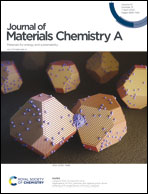Dual-functional iodine photoelectrode enabling high performance photo-assisted rechargeable lithium iodine batteries†
Abstract
An integrated battery system, which integrates solar power and a rechargeable battery in the same unit, is an effective solution for the shortage and inefficiency of power energy. We initially present an integrated photo-assisted rechargeable lithium–iodine (Li–I2) battery system using a hybrid I2/N719-dye/TiO2 composite as a dual-functional photoelectrode. In this integrated battery system, the photovoltage generated on the hybrid photoelectrode compensates for the charging voltage of the cell, which decreases the charging potential by ∼100 mV under a chronoamperometry test. To be exact, under illuminated conditions, the integrated Li–I2 battery extends the charge/discharge capacity from 171/166 mA h g−1 to 204/193 mA h g−1, with a higher energy efficiency of 93% (output electric energy/input electric energy) compared to that of an Li–I2 battery (that is ∼87%). Furthermore, the accelerated redox kinetics of lithium polyiodine conversion are also revealed by the enhanced electrochemical behavior and density functional theory calculation. We believe that such a design with an integrated photo-assisted rechargeable Li–I2 battery can hew out a new way to realize the application of efficient solar energy conversion and storage.



 Please wait while we load your content...
Please wait while we load your content...